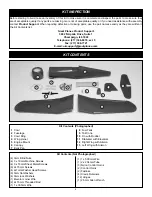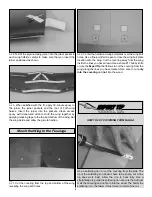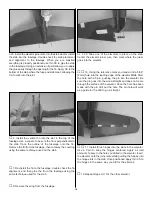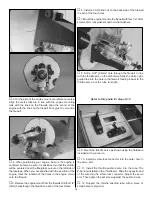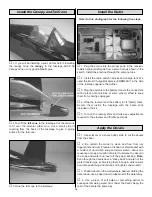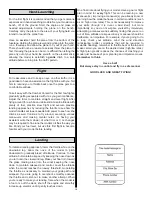
19
For the first flight it is recommended that you get someone
experienced in hand-launching models. Set your model on a
bench, off of the ground. Start the engine and make all
needed adjustments holding the plane on the bench.
Carefully carry the plane to the area of your flying field you
intend to launch the plane from.
Have an assistant hold the plane from the bottom of the
fuselage. Holding the plane level and pointing into the wind,
run a few steps and allow the plane to fly out of your hand.
There should not be a reason to actually throw the plane. In
fact, throwing the plane can be more difficult than letting the
plane fly out of your hand. Be smooth on the elevator stick,
allowing the model to establish a gentle climb to a safe
altitude before turning into the traffic pattern.
For reassurance and to keep an eye on other traffic, it is a
good idea to have an assistant on the flight line with you. Tell
him to remind you to throttle back once the plane gets to a
comfortable altitude.
Take it easy with the Combat Corsair for the first few flights,
gradually getting acquainted with it as you gain confidence.
Adjust the trims to maintain straight and level flight. After
flying around for a while and while still at a safe altitude with
plenty of fuel, practice slow flight and execute practice
landing approaches by reducing the throttle to see how the
model handles at slower speeds. Add power to see how she
climbs as well. Continue to fly around, executing various
maneuvers and making mental notes (or having your
assistant write them down) of what trim or C.G. changes
may be required to fine tune the model so it flies the way you
like. Mind your fuel level, but use this first flight to become
familiar with your model before landing.
To initiate a landing approach, lower the throttle while on the
downwind leg. Allow the nose of the model to pitch
downward to gradually bleed off altitude. Continue to lose
altitude, but maintain airspeed by keeping the nose down as
you turn onto the crosswind leg. Make your final turn toward
the grass landing area (into the wind) keeping the nose
down to maintain airspeed and control. Level the attitude
when the model reaches the runway threshold, modulating
the throttle as necessary to maintain your glide path and
airspeed. If you are going to overshoot, smoothly advance
the throttle and climb out to make another attempt. When
you’re ready to make your landing, flare when the model is
a foot or so off the deck, shut off the engine and smoothly
increase up elevator until it gently touches down.
One final note about flying your model. Have a goal or flight
plan in mind for every flight. This can be learning a new
maneuver(s), improving a maneuver(s) you already know, or
learning how the model behaves in certain conditions (such
as on high or low rates). This is not necessarily to improve
your skills (
though it is never a bad idea!), but more
importantly so you do not surprise yourself by impulsively
attempting a maneuver and suddenly finding that you’ve run
out of time, altitude or airspeed. Every maneuver should be
deliberate, not impulsive. For example, if you’re going to do
a loop, check your altitude, mind the wind direction
(anticipating rudder corrections that will be required to
maintain heading), remember to throttle back at the top and
make certain you are on the desired rates (high/low rates).
A flight plan greatly reduces the chances of crashing your
model just because of poor planning and impulsive moves.
Remember to think.
Have a ball!
But always stay in control and fly in a safe manner.
GOOD LUCK AND GREAT FLYING!
Landing
Flight
Hand-Launching

